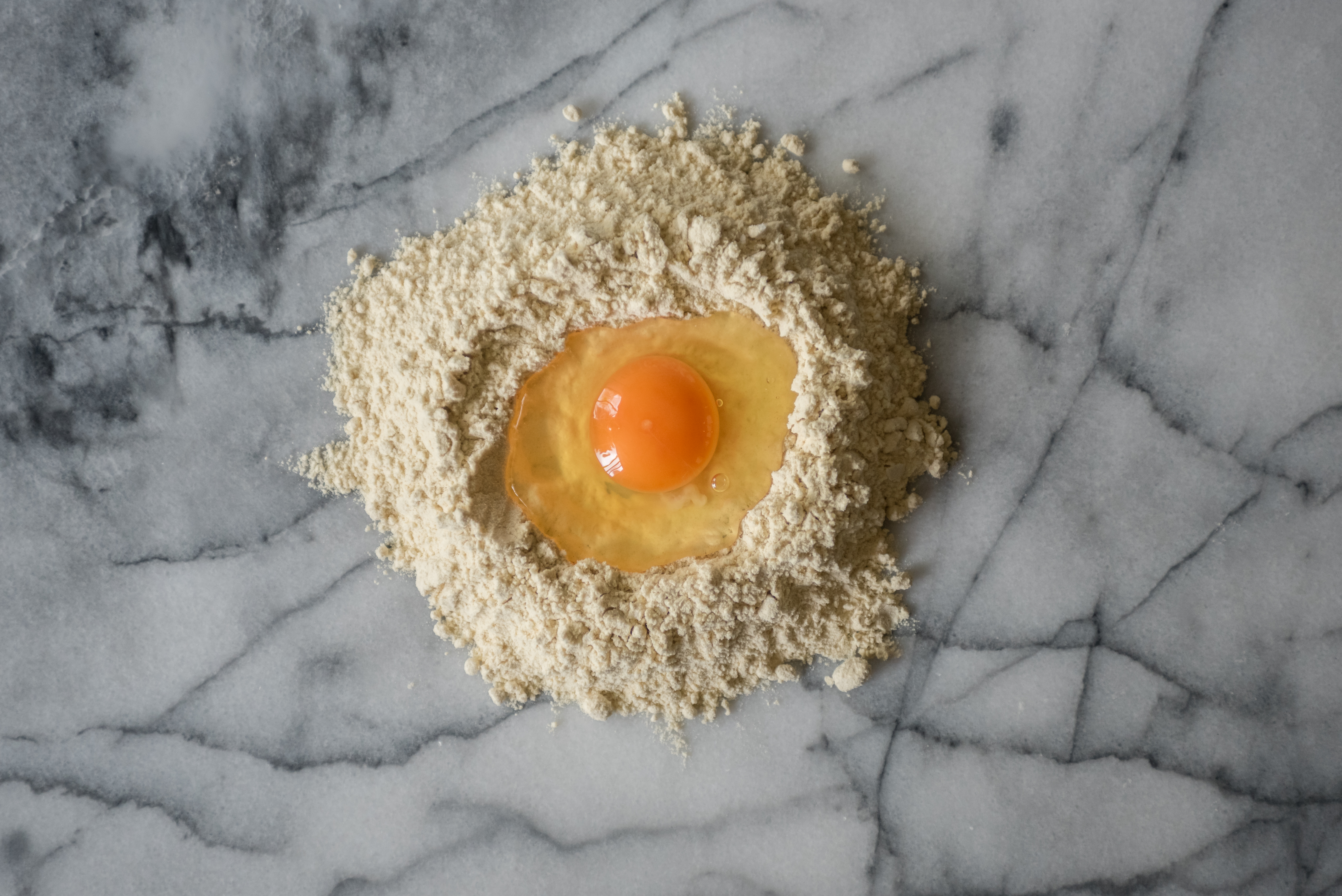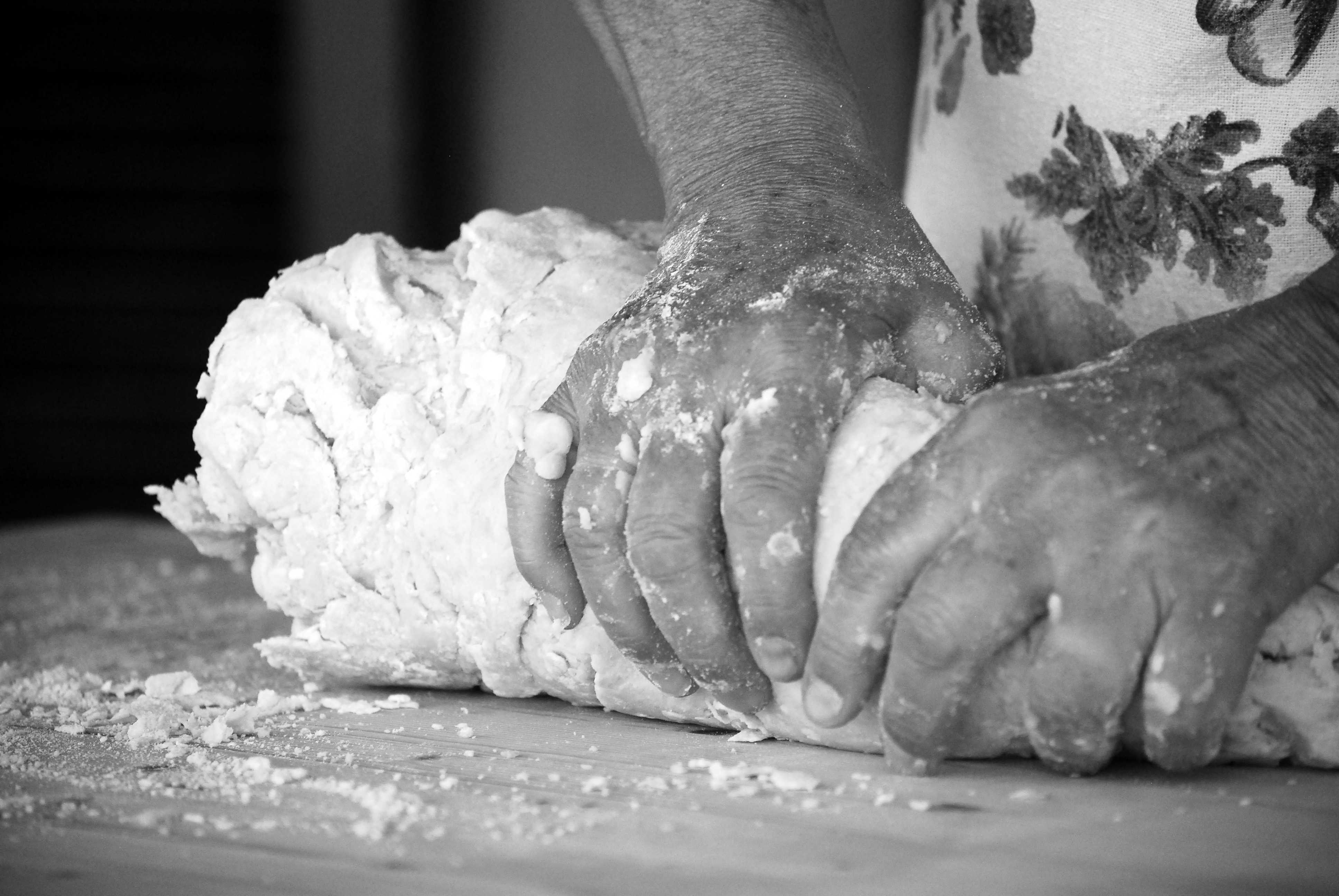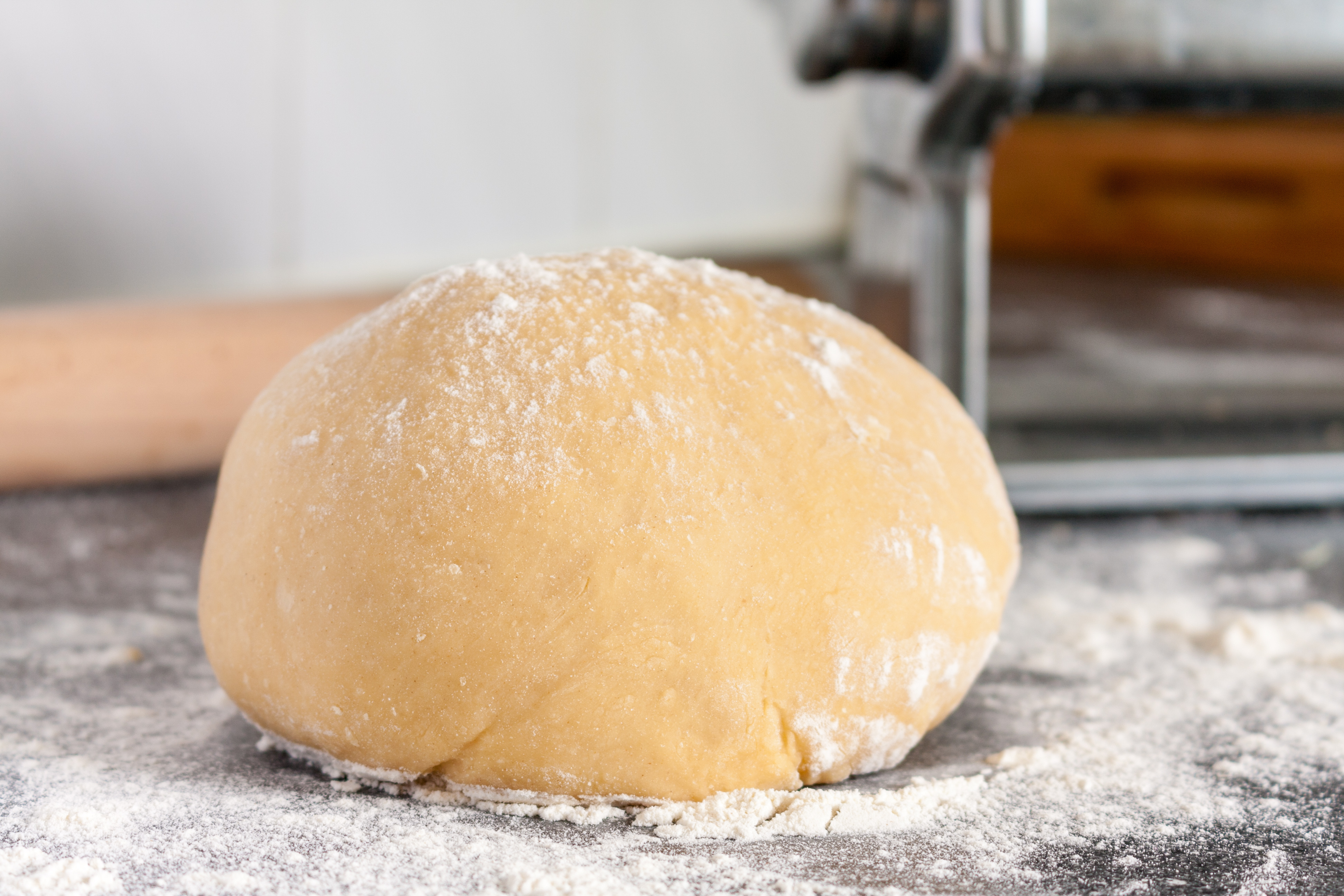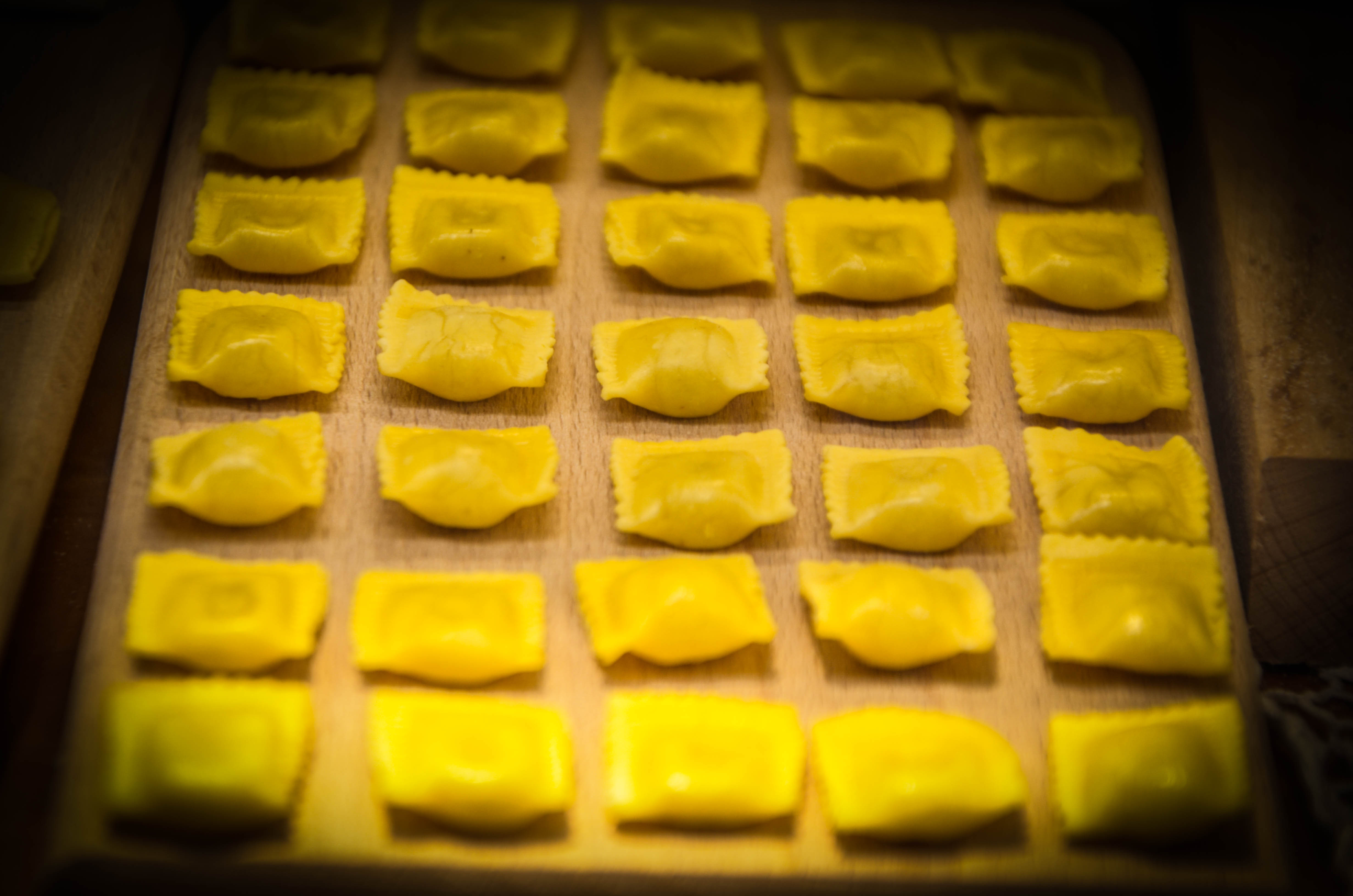Pasta is something a lot of us probably take for granted. We open those cardboard boxes or tear into plastic packing, drop some noodles into boiling water, and wait ten or so minutes for deliverance from hunger. There’s nothing wrong with dry pasta. It’s gotten us all through hunger pangs more times than we can probably count. But still…
Fresh pasta is one of those super simple food items that feels like a luxury. Still, if you want it to transcend good and become great at making pasta, it’ll take work. A lot of work. It takes patience. A lot. And it requires very good ingredients. Which shouldn’t be too hard to pull off since there are only two ingredients involved.
“It’s just flour and eggs,” you assure yourself. “How difficult can that be?” Cut to a glutinous mess on your countertop that never reaches the heights your first proper plate of fresh pasta revealed to you. Don’t give up! Try again. And again. Eventually, you’re going to get it right. You will reach those heights of great pasta if you put in the time and elbow grease.
The Sweetest Pasta Origin Story Ever
I love making pasta. I love making it so much that I have a dedicated apron just for when I make pasta. Yes, I’m that much of a food nerd. I’m also self-aware enough to know that my recipe will never be perfect. Pasta don’t play like that. It’s constantly evolving medium that’s dependent on the time of year, ingredients available, and mood you’re in at the time. Sometimes you end up with a tagliatelle for a bolognese. Sometimes I end up with ravioli. Sometimes I end up with a mess.
I had the chance this year to make and eat pasta with the Rana family at their estate(s) in Verona, Italy. I was not giving up a chance to hone my pasta skills with the family that basically introduced fresh pasta to the consumer market after World War II.
Back then Giovanni Rana would ride his ruby red bike around his postcard perfect northern Italian streets and deliver fresh pasta for his neighbors from a big wicker basket. Mama would stay home and get dinner ready while he set out through the town, flour still on his hands. His son, Gian Luca, would ride in the basket and hand out the packages and collect the coins. When I first heard this story, I could only envision Antonioni shooting it in anamorphic black and while Franco Corelli’s iconic tenor tore at your heartstrings.
If there was ever anyone to get a lesson from in the finer arts of the form, these were the people. They’ve been making pasta for 67 years and took their humble door-to-door pasta delivery service and turned it into an international concern with factories in Verona and Chicago and restaurants all over the world. Needless to say, pasta runs deep through the veins of the Rana family.
The Six Rules For Making Perfect Pasta
Gian Luca Rana — Giovanni’s son and CEO of the Rana empire — is the sort of Italian guy who doesn’t break eye contact when you’re in a conversation. He engages, makes you comfortable, and listens simply through his body language. He wants to understand where you’re coming from as much as he wants to impart whatever he can into a conversation. He loves, loves making pasta and helping people get better at it. He’d prefer you eat his pasta — he’s a businessman with a family to feed after all — but, he’s not afraid to guide people to the best results either.
These are the practices and tactics I learned from Gian Luca Rana while he taught me to make a humble raviolo.
1. Great flour is imperative.
Rana’s first bit of advice, “use of a blend of high-quality flours, which are extremely pure and have a high protein content. Our blend is made of flour and semolina, ingredients that give softness, elasticity, and consistency to the pasta.”
A blend of Type 00 flour and semolina is what makes or breaks a great pasta dough.
Type 00 is a high protein and very finely milled flour. The moniker “Type 00” refers to the milling (or fineness of the flour). It doesn’t refer to the quality of the wheat involved. You should always look for a “heritage wheat” grain when buying. That way you avoid overly modified wheat which is common among the average bread flour in America even if it’s marked Type 00.
Semolina is more straightforward. It’s a byproduct of the wheat-to-flour milling process called wheat middlings. Wheat middlings is what’s left with the endosperm (the part that makes flour) is separated from the bran or germ part of the wheat. That makes semolina very high in protein along with a lot of vitamins and minerals.
Now, your decision on who much semolina you mix into your pasta is entirely up to you and your palate. I tend to use a 3:1 ratio of type 00 to semolina because I like my pasta with a little heft. Rana, holding his family’s recipe close to his chest, doesn’t disapprove, so let’s move on.
2. Source the best eggs.

Eggs are paramount in the process of making pasta. A great yolk is crucial. 33% of the yolk is fat and the rest is water and protein. That fat is what makes pasta shine. And for the yolk to be good enough for your pasta, the chicken must live a good life with the best food.
“Hens must have a natural and balanced diet in order to receive all the necessary macronutrients: The right protein intake and fat to the eggs,” Rana conveys. “The color of the yolk is 100% natural due to the natural feed and not due to the addition of synthetic pigments.”
Translation: Go to a farmer’s market or even a farm if you have to and get the best quality, fresh eggs. Talk to the farmers and find out how the chickens live, what they’re fed, and how long ago the eggs were laid. Especially ask how dark they think the yolks should be. Sometimes farmers will feed their hens marigold flowers to artificially darken yolks without spending money on good feed. So, talk to the people you’re buying food from.
3. How to make the dough.

This is where things get sticky. Rana starts in on a speech that leaves me a little dizzy. “There is no universal number for the best egg to flour ratio. There are many parameters to consider in order to obtain the perfect dough with the best ratio of egg to flour. For example, a high-quality flour contains a lot of protein. Therefore, it is not necessary to add too many eggs. Instead, if you want pasta dough that is more yellow, you need to add more yolks. And remember, each yolk can have a different size! Last but not least, it’s important to consider the elasticity of the dough that allows you to obtain the requested thickness. So, given all those elements — plus the weather which impacts the dough through humidity, heat, cold, dryness — you understand why making pasta is an art, it’s love, not just a technique!”
The best way forward is to experiment. Place two heaping cups of your flour mix on a flat surface and make a crater in the middle like a spent volcano. Add two eggs with two additional yolks and start to scramble like you’re whipping up Sunday morning breakfast. The flour will slowly start to mix in. Does it look nice and yellow like you want it to? No? Add another egg yolk and keep scrambling. Eventually, you’ll have a very rough dough that you’ll need to knead and knead and knead.
Around 5 minutes into kneading, I realize I never, ever want to get slapped by an Italian nonna. The sheer strength in those hands from a lifetime of making pasta is probably just shy of taking a pistol to the face.
Rana warns while I knead, “fresh pasta is a very delicate product and it is crucial to keep it moist so that it doesn’t dry which is necessary to obtain the best dough.”
What you’re aiming for is a dough that’s moist but doesn’t stick to your work surface. In the end, it should form a very smooth yellow ball about the size of a softball.
4. Rest.

Resting your pasta is imperative. “The handmade pasta dough needs to rest for a long time to allow the protein to reactivate,” Rana says, with a bit of wonder and a dose of respect. “This eases the processing of the dough, making it easier to roll it out with the rolling pins. This is important because the strength required to pull the dough varies from person to person and the workmanship is never the same or constant.”
I wrap up my dough in a piece of plastic wrap and it goes into a fridge for about 30-45 minutes.
It’s Negroni time!
5. Roll it out and decide what you’re making.
Using a thin rolling pin, roll your dough out on a generously floured surface. Again, you want the dough to stay moist, but never sticky. This just takes time to master. You roll and fold and roll again. Repeat. Sip Negroni. Fold and roll and then repeat the whole process again.
The end product should be yellow, thin, and still have moisture to it. From this point, your pasta can be anything. If you want to slice up some tagliatelle, this is where you’d do it. Or maybe start piling up a lasagna.
I ask Rana about the contentious water to salt ratio for boiling pasta. He, of course, has an exacting response locked and loaded. “It is important not to use too much salt because if the water is too salty it alters and ruins the taste of the pasta. Our suggestion is to use 0.176 ounces of salt per 2.11 pints of water. The best tip is adding the salt to the water before the pasta, so the salt can dissolve and give the right saltiness to the water.”
I’m in no way surprised by Rana’s exact numbers at this point. I think the Negroni has numbed me.
We’re making ravioli, so I roll the dough out until it’s paper thin. And, I figure since I’m standing next to a man who’s spent his life perfecting tortellini and ravioli, I’d better ask about what to put in mine.
“Inspiration comes from the raw ingredients!” Rana extolls. “The ingredients need to be known, understood, observed, respected, and tasted of course. This is an approach that allows us to express our creativity without any limit, in the continuous search for the unique flavor.” I take a large swig from my Negroni as my eyes widen listening to a man who truly loves what he does.
Rana hands me fresh Genovese basil, fresh local ricotta from a farm nearby, Parmigiano Reggiano from Emilia-Romagna. That’s it. Simple. Concise. Delicious.
I chop the basil while Rana gets excited about all the ways you can fill a tortellini or ravioli. It’s kind of like an Italian version of the shrimp scene from Forrest Gump. “Italian cuisine is an incredible source of inspiration to create new recipes but we also like to look to the gastronomic culture of other countries and to the new food trends. We created fillings inspired by typical dishes from Spain, India, Greece, and Mexico. We created tortellini filled with paella, chicken and curry, chili, feta cheese, olives…” Rana continues, but I lose track somewhere around something about “Maine” and “shrimp and lobster.”
I dollop out my mix of cheese and basil into little sections. Next, I use an egg white wash to create a grid system that’ll bind the top layer of pasta around the ravioli when you fold the pasta sheet over.
Once the pasta is folded over and all pressed down around the filling, we cut out the ravioli. This, again, is up to you. Use a form. Use a knife. Make little hearts or devil heads. You do you.
6. Cooking the perfect ravioli.

People often mistakenly boil tortellini and ravioli in a big pot as they would pasta. That’s not always the best way, especially if you’re talking small morsel like our ravioli.
Rana has one last bit of advice for me, “a perfect raviolo is the right combination between thin dough and a tasty filling, both made with the best raw ingredients to create an explosion of flavor at the first bite. Therefore, you can follow northern Italian tradition using the butter or southern ones preferring extra virgin olive oil. In both cases, you can add on top some Parmigiano Reggiano cheese and the perfect raviolo is ready!”
Since we’re in northern Italy, I, of course, opt for butter. A large saucepan is heated and the butter is melted just to the point before it starts to brown. The ravioli get tossed in and sprinkled with salt and cracked black pepper. The pan almost never stops moving. You want to toss the ravioli so they get coated with butter and then hit them with about a cup of boiling water.
That water’s going to boil off and cook the ravioli through and leave them coated with a delicious buttery sauce. From here you can add fresh sage and let it bloom in the butter or even more fresh basil. Just make sure you don’t let the pan sit on the heat without moving it. Otherwise, the pasta will stick, fall apart, and burn.
Plate the ravioli. Garnish as you see fit. Sprinkle with freshly grated parmesan. Done.
Now it’s time to eat … and order another Negroni.






